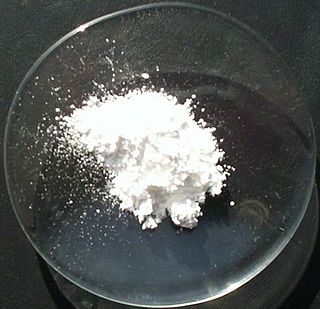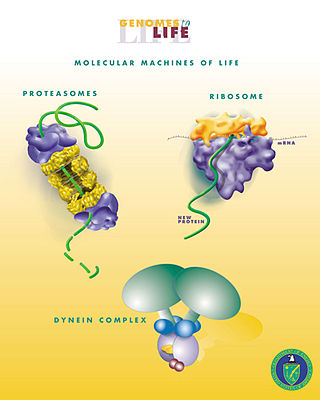Related Research Articles

Magnesium oxide (MgO), or magnesia, is a white hygroscopic solid mineral that occurs naturally as periclase and is a source of magnesium (see also oxide). It has an empirical formula of MgO and consists of a lattice of Mg2+ ions and O2− ions held together by ionic bonding. Magnesium hydroxide forms in the presence of water (MgO + H2O → Mg(OH)2), but it can be reversed by heating it to remove moisture.

A hydrogel is a biphasic material, a mixture of porous, permeable solids and at least 10% by weight or volume of interstitial fluid composed completely or mainly by water. In hydrogels the porous permeable solid is a water insoluble three dimensional network of natural or synthetic polymers and a fluid, having absorbed a large amount of water or biological fluids. These properties underpin several applications, especially in the biomedical area. Many hydrogels are synthetic, but some are derived from nature. The term 'hydrogel' was coined in 1894.

Nanomaterials describe, in principle, materials of which a single unit is sized between 1 and 100 nm.

Forsterite (Mg2SiO4; commonly abbreviated as Fo; also known as white olivine) is the magnesium-rich end-member of the olivine solid solution series. It is isomorphous with the iron-rich end-member, fayalite. Forsterite crystallizes in the orthorhombic system (space group Pbnm) with cell parameters a 4.75 Å (0.475 nm), b 10.20 Å (1.020 nm) and c 5.98 Å (0.598 nm).

Titanium diboride (TiB2) is an extremely hard ceramic which has excellent heat conductivity, oxidation stability and wear resistance. TiB2 is also a reasonable electrical conductor, so it can be used as a cathode material in aluminium smelting and can be shaped by electrical discharge machining.

A nanoparticle or ultrafine particle is usually defined as a particle of matter that is between 1 and 100 nanometres (nm) in diameter. The term is sometimes used for larger particles, up to 500 nm, or fibers and tubes that are less than 100 nm in only two directions. At the lowest range, metal particles smaller than 1 nm are usually called atom clusters instead.

In cellular biology, mechanotransduction is any of various mechanisms by which cells convert mechanical stimulus into electrochemical activity. This form of sensory transduction is responsible for a number of senses and physiological processes in the body, including proprioception, touch, balance, and hearing. The basic mechanism of mechanotransduction involves converting mechanical signals into electrical or chemical signals.

Nanocomposite is a multiphase solid material where one of the phases has one, two or three dimensions of less than 100 nanometers (nm) or structures having nano-scale repeat distances between the different phases that make up the material.

A nanocrystalline (NC) material is a polycrystalline material with a crystallite size of only a few nanometers. These materials fill the gap between amorphous materials without any long range order and conventional coarse-grained materials. Definitions vary, but nanocrystalline material is commonly defined as a crystallite (grain) size below 100 nm. Grain sizes from 100–500 nm are typically considered "ultrafine" grains.

Manganese(II,III) oxide is the chemical compound with formula Mn3O4. Manganese is present in two oxidation states +2 and +3 and the formula is sometimes written as MnO·Mn2O3. Mn3O4 is found in nature as the mineral hausmannite.

Magnesium hydride is the chemical compound with the molecular formula MgH2. It contains 7.66% by weight of hydrogen and has been studied as a potential hydrogen storage medium.

Nanodiamonds, or diamond nanoparticles, are diamonds with a size below 100 nanometers. They can be produced by impact events such as an explosion or meteoritic impacts. Because of their inexpensive, large-scale synthesis, potential for surface functionalization, and high biocompatibility, nanodiamonds are widely investigated as a potential material in biological and electronic applications and quantum engineering.
Severe plastic deformation (SPD) is a generic term describing a group of metalworking techniques involving very large strains typically involving a complex stress state or high shear, resulting in a high defect density and equiaxed "ultrafine" grain (UFG) size or nanocrystalline (NC) structure.
Zinc ferrites are a series of synthetic inorganic compounds of zinc and iron (ferrite) with the general formula of ZnxFe3−xO4. Zinc ferrite compounds can be prepared by aging solutions of Zn(NO3)2, Fe(NO3)3, and triethanolamine in the presence and in the absence of hydrazine, or reacting iron oxides and zinc oxide at high temperature. Spinel (Zn, Fe) Fe2O4 appears as a tan-colored solid that is insoluble in water, acids, or diluted alkali. Because of their high opacity, zinc ferrites can be used as pigments, especially in applications requiring heat stability. For example, zinc ferrite prepared from yellow iron oxide can be used as a substitute for applications in temperatures above 350 °F (177 °C). When added to high corrosion-resistant coatings, the corrosion protection increases with an increase in the concentration of zinc ferrite.

Younan Xia is a Chinese-American chemist, materials scientist, and bioengineer. He is the Brock Family Chair and Georgia Research Alliance (GRA) Eminent Scholar in Nanomedicine in the Wallace H. Coulter Department of Biomedical Engineering, with joint appointments in the School of Chemistry & Biochemistry, the School of Chemical & Biomolecular Engineering, and Parker H. Petit Institute for Bioengineering & Bioscience at the Georgia Institute of Technology.
A simulated body fluid (SBF) is a solution with an ion concentration close to that of human blood plasma, kept under mild conditions of pH and identical physiological temperature. SBF was first introduced by Kokubo et al. in order to evaluate the changes on a surface of a bioactive glass ceramic. Later, cell culture media, in combination with some methodologies adopted in cell culture, were proposed as an alternative to conventional SBF in assessing the bioactivity of materials.

Niobium diboride (NbB2) is a highly covalent refractory ceramic material with a hexagonal crystal structure.
Titanium foams exhibit high specific strength, high energy absorption, excellent corrosion resistance and biocompatibility. These materials are ideally suited for applications within the aerospace industry. An inherent resistance to corrosion allows the foam to be a desirable candidate for various filtering applications. Further, titanium's physiological inertness makes its porous form a promising candidate for biomedical implantation devices. The largest advantage in fabricating titanium foams is that the mechanical and functional properties can be adjusted through manufacturing manipulations that vary porosity and cell morphology. The high appeal of titanium foams is directly correlated to a multi-industry demand for advancement in this technology.
Nanotech metallurgy is an emerging interdisciplinary domain of materials science and engineering, manufacturing, and nanoscience and engineering to study how nanophases can be applied to significantly improve the processing/manufacturing, micro/nano-structures, and physical/chemical/mechanical behaviors of metals and alloys. This definition was first proposed by Xiaochun Li at the University of California, Los Angeles in 2018.
Hans-Jörg Fecht is Chaired Professor at the University of Ulm, Germany in the departments of Engineering and Computer Science. He is also an Office Director of the EUREKA Cluster Metallurgy Europe in the Same university, and a member of the European Academy of Sciences and Arts. He has published over 450 scientific publications, directed numerous national, European, and international research initiatives.
References
- ↑ "The Future Nobel laureate: Alireza Yaghoubi (page:24-25)". University of Malaya. Retrieved 5 April 2014.
- ↑ "The airline seats of the future: Mesh lounge chairs, personal overhead bins". skift.com. 19 February 2013. Retrieved 5 April 2014.
- ↑ Alireza Yaghoubi publications indexed by Google Scholar
- ↑ "Easing the squeeze: Designers rethink the middle seat". NBC News. 20 August 2013. Retrieved 5 April 2014.
- ↑ "The future of airline seating? Let's hope so". ABC News. 19 February 2013. Retrieved 5 April 2014.
- ↑ "Economy seating for the 21st century airline". The Christian Science Monitor. 20 February 2013. Retrieved 5 April 2014.
- ↑ "Future aeroplane seats". The Economist. 1 March 2013. Retrieved 5 April 2014.
- ↑ "Travelers might have lost the class war". USA Today. 3 February 2014. Retrieved 5 April 2014.
- ↑ "AirGo Design". AirGo Design. Retrieved 5 April 2014.
- ↑ Afshar-Mohajer, M.; Yaghoubi, A.; Bushroa, A.R.; Chin, K.M.C.; Tin, C.C; Chiu, W.S.; Chiu, W.S. (2014). "Electrophoretic deposition of magnesium silicates on titanium implants: Ion migration and silicide interfaces". Applied Surface Science. 307: 1–6. doi:10.1016/j.apsusc.2014.04.033.
- ↑ Ramesh, S.; Yaghoubi, A.; Lee, K.Y.S.; Chin, K.M.C.; Purbolaksono, J.; Hamdi, M.; Hassan, M.A.; Hassan, M.A. (2013). "Nanocrystalline forsterite for biomedical applications: Synthesis, microstructure and mechanical properties". Journal of the Mechanical Behavior of Biomedical Materials. 25: 63–69. doi:10.1016/j.jmbbm.2013.05.008. PMID 23726923.
- ↑ Tan, C.Y.; Yaghoubi, A.; Ramesh, S.; Adzila, S.; Purbolaksono, J.; Hassan, M.A.; Kutty, M.G.; Kutty, M.G. (2013). "Sintering and mechanical properties of MgO-doped nanocrystalline hydroxyapatite". Ceramics International. 39 (8): 8979. doi:10.1016/j.ceramint.2013.04.098.
- ↑ Yaghoubi, A.; Mélinon, P. (2013). "Tunable synthesis and in situ growth of silicon-carbon mesostructures using impermeable plasma". Scientific Reports. 3: 1083. Bibcode:2013NatSR...3E1083Y. doi:10.1038/srep01083. PMC 3547321 . PMID 23330064.
- ↑ "Major advances in dye sensitized solar cells". Phys.org. 23 April 2014. Retrieved 24 April 2014.
- ↑ Tsai, H.W.; Wang, T.H.; Chan, T.C.; Chen, P.J.; Chung, C.C.; Liao, C.N.; Yaghoubi, A.; Diau, E.W.G.; Chueh, Y.L. (2014). "Fabrication of Large Scale Single Crystal Bismuth Telluride (Bi2Te3) Nanosheet Arrays by Single Step Electrolysis Process". Nanoscale. 6 (14): 7780–5. Bibcode:2014Nanos...6.7780T. doi:10.1039/C4NR00184B. PMID 24770854.
- ↑ Chiu, W.S.; Yaghoubi, A.; Chia, M.Y.; Khanis, N.H.; Rahman, S.A.; Khiew, P.S.; Chueh, Y.L. (2014). "Self-assembly and secondary nucleation in ZnO nanostructures derived from a lipophilic precursor". CrystEngComm. 16 (27): 6003. doi:10.1039/C4CE00442F.
- ↑ "UM Undergraduate Scores a World First". Center for High Impact Research, University of Malaya. 18 February 2013. Archived from the original on 2 November 2013. Retrieved 5 April 2014.
- ↑ "IMechE Malaysia Branch Quarterly Newsletter" (PDF). Institute of Mechanical Engineers (UK). 1 October 2013. Retrieved 5 April 2014.